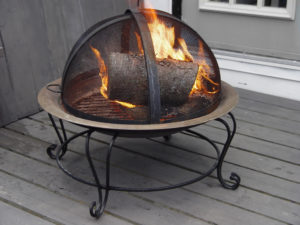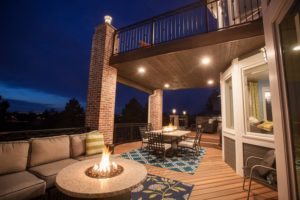How Do You Fireproof a Timber Deck?
By Dave KileWhen you consider fire dangers around your home, don’t neglect ways to fireproof your deck. Whether you’re using a barbecue or tiki torches, there are several considerations, some small, some larger.
 Fireproofing is essential, especially in light of the early 2020 bushfires that caused mass destruction: Up to 19 million hectares were burnt, with 33 lives lost and around 3,094 homes destroyed. We cannot forget this devastating event, and we all can make a difference by taking steps around our house. Here are several ways you can help reduce risks when it comes to your deck.
Fireproofing is essential, especially in light of the early 2020 bushfires that caused mass destruction: Up to 19 million hectares were burnt, with 33 lives lost and around 3,094 homes destroyed. We cannot forget this devastating event, and we all can make a difference by taking steps around our house. Here are several ways you can help reduce risks when it comes to your deck.
Attached Decks and Bushfire
Timber decks can become fuel for a bushfire, but there are a number of ways to be proactive. You don’t want to be in the line of a bushfire or to start one by carelessly handling fire sources. Here are five quick ways to reduce your risk:
- Remove fire fuel. Whether it’s patio furniture, dried out vegetation or debris, clear off the deck.
- Never leave a fire unattended. If you’re grilling, don’t step away. Be sure to completely extinguish the fire when you are done. Depending on the layout of the deck and your fuel source, it may be safest not to have a grill or fire pit on the deck. Check your local regulations, as some areas don’t permit open flames on a deck.
- Keep water hoses and fire extinguishers nearby. A Class A fire extinguisher is for ordinary combustibles.
- Avoid storing logs, petrol, or any other fuel under the deck. Cut back trees and bushes. Create as much defensible space as possible in the event of a bushfire — keep vegetation at least 9 meters from your home and deck, more if possible (30+ meters is ideal). If you must have plants near your deck, choose those that are most fire-resistant. Create even more defensible space by landscaping with stone walls, patios, and sidewalks/roadways.
Risk Factors
Decks often catch fire in two ways: 1. A burning branch lands on the deck surface. If there are wide gaps between the decking boards, the airflow can fan the flames. 2. Dried out vegetation on or near the deck catches fire. This situation is especially dangerous if it is lit from underneath. As stated earlier, storing any fuel source beneath the deck — from petrol to timber logs for the fireplace — literally fuels the fire.
Protecting Decks, Patios, and Porches
Fire needs oxygen, fuel and heat to spread. The air between your deck boards – no matter your deck material: timber decking, wood-composite plastic (WPC products) or composite decking materials — can provide the oxygen and the timber can provide the fuel. Thus, you must lessen the elements needed for spread.
Embers, which include burning twigs and leaves, are the most common way houses catch fire during a brush fire. They can land on debris in your gutters or be blown onto your deck by the wind.
Decks, patios and porches can be protected by following the above guidance and also by enclosing the space below your deck, especially if it’s a two-story deck. Using an under-deck drainage system, the area below your deck can become an enclosed space, which helps to close off any airflow between your deck boards and reduce the chance a fire will spread.
Fireproofing an Existing Timber Deck
To make an existing deck more fireproof, use a flame-retardant spray. You might also add metal sheathing around the base timbers to create more fire-resistant decks. Ask your local home improvement professional for the best recommendation. Additionally, as stated above, be sure to remove combustible materials from above and below the deck.
Look for any decaying timber and replace it immediately.
Protect the ledger board where the house attaches to the deck. Install flashing to create a barrier to embers. Bonus, this also will prevent water from penetrating and rotting this timber.
Build Fireproofing into a New Deck Installation
Check all local building codes when building a new deck. Talk to your builder about the best options for fireproofing and the following considerations.
- Site: One of the most significant risks for a new deck depends on where you build it. Decks constructed at the top of a slope have the greatest risk from brush fires. The Country Fire Authority states, “A fire will burn faster uphill. This is because the flames can easily reach more unburnt fuel in front of the fire. Radiant heat pre-heats the fuel in front of the fire, making the fuel even more flammable. For every 10˚ slope, the fire will double its speed.” Avoid building at the top of a slope, if possible. Orient the deck on the side of the house if that helps. Also, avoid constructing in areas with heavy vegetation.
- Fire-resistant decking products and materials: Building materials also matter. Be sure to use non-combustible or fire-resistant materials or apply an exterior fire retardant spray. The bigger the timbers, the better. Install non-combustible sheathing on the bottom of the joists, but be sure to create a way for water to drain. Apply metal flashing, and be sure to tuck it behind the lap-joist where it terminates. When choosing decking boards, consider Class A–rated composite materials made from PVC and wood fibre. Most timber species are rated Class C for fire resistance. Make sure any deck skirting, stairs or railings are also fire-resistant.
This Old House provides more guidance on fireproof construction, including using concrete forms and wall panels.
Can you Have a Fire Pit on Timber Deck?
 Fire pits can be placed on a timber deck, but only with extreme caution. Here are a few tips to improve safety:
Fire pits can be placed on a timber deck, but only with extreme caution. Here are a few tips to improve safety:
- A fire pit should ideally be at least 3 meters away from your house. That rules out many decks, but not all. You could also enjoy it near a concrete patio or lawn deck.
- Place the fire pit away from anything flammable, including furniture and overhangs.
- Use a fire pit pad to protect against gas, ash and embers. You can purchase a pad in many different colours to complement your fire pit and deck. Always use the stand that comes with the firepit. Never put a fire pit directly on a timber deck.
- Avoid using a firepit on a windy day.
- Use a fire pit spark screen to avoid flying embers.
- Keep a poker tool nearby to control logs.
- Pour about 6 cm of sand at the bottom of your firepit before lighting it. The sand provides extra protection between the fire and anything beneath it.
What Type of Timber is Fire Resistant?
While there are no fireproof plants or fireproof timbers, you can select more high moisture or denser varieties that significantly reduce your risks. The denser the timber, the better when it comes to fire resistance, as it takes longer to burn. Go for hardwoods such as Australian beech, spotted gum, or ironbark. Teak or Ipe, both exotic hardwoods, are naturally resistant to rot and decay. Redwoods are softwoods, but resistant to fire.
Is Pressure-Treated Timber Fire Resistant?
Standard pressure-treated timber is not fire-resistant. However, timber treated with fire-retardant chemicals significantly slows the spread of fire. Avoid untreated timber.
Creating a fireproof deck takes planning and maintenance. However, the risk reduction will give you peace of mind.